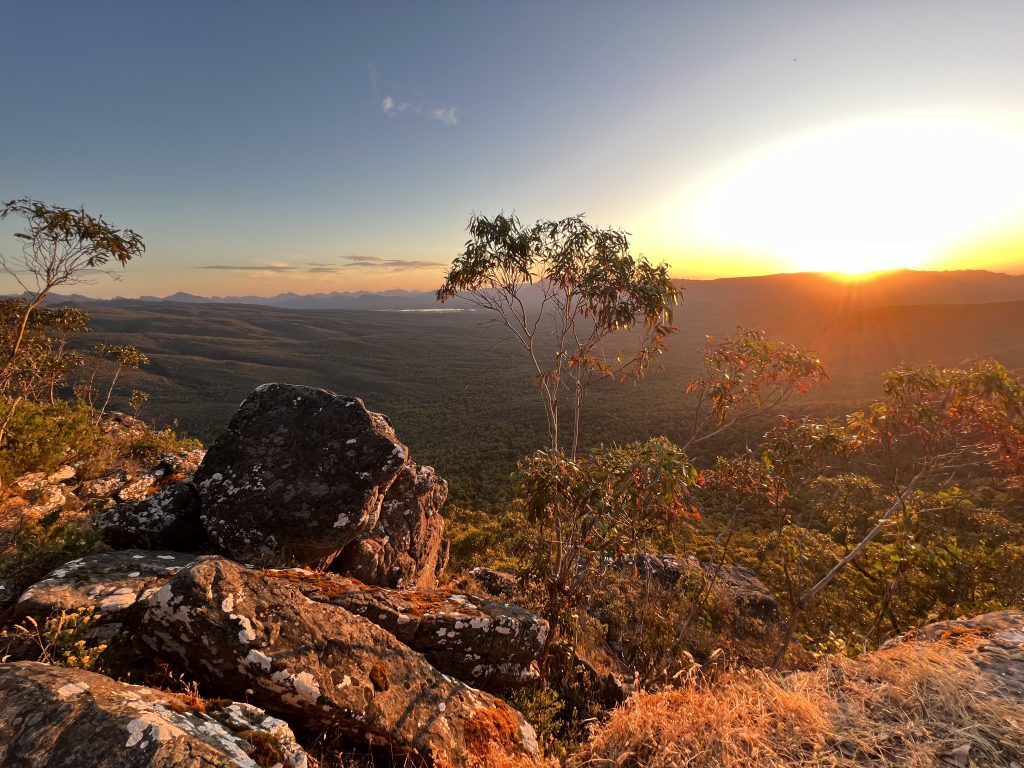
TL;DR
A month in Australia at Christmas 2022. I flew to see my first grandson in Sydney, Australia, spent Christmas with family, visited Canberra, met old friends in Newcastle and Melbourne, made a pilgrimage to Gariwerd and learnt about Country and First Nations.
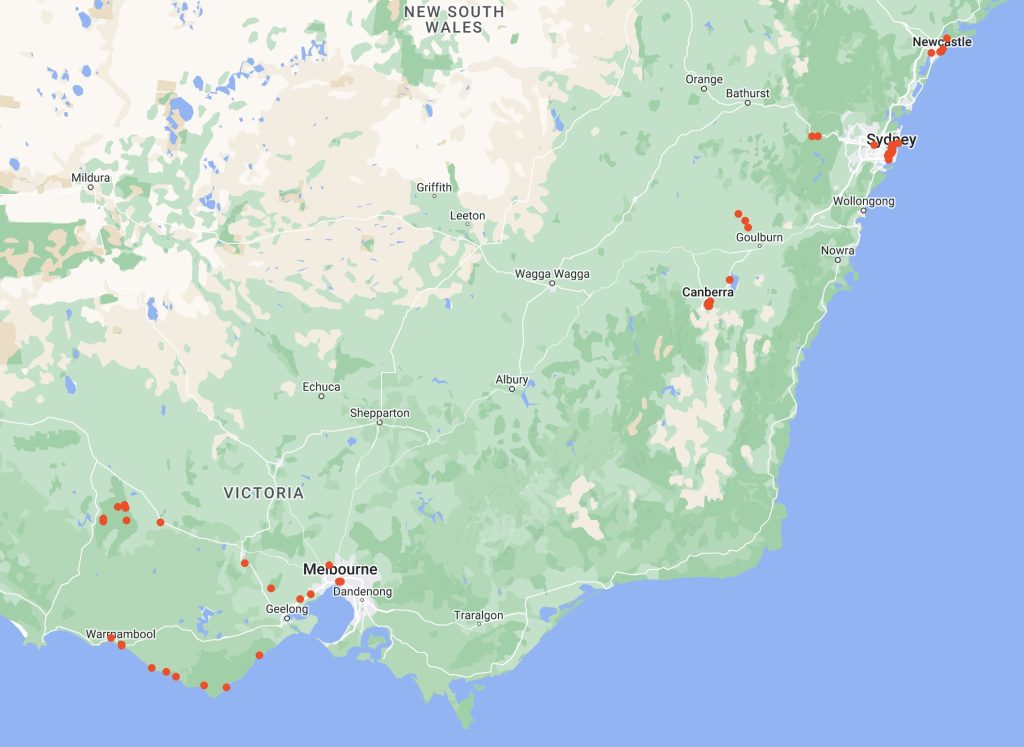
REWIND: Tuesday 2 August 2022 – My first son’s first son is born.
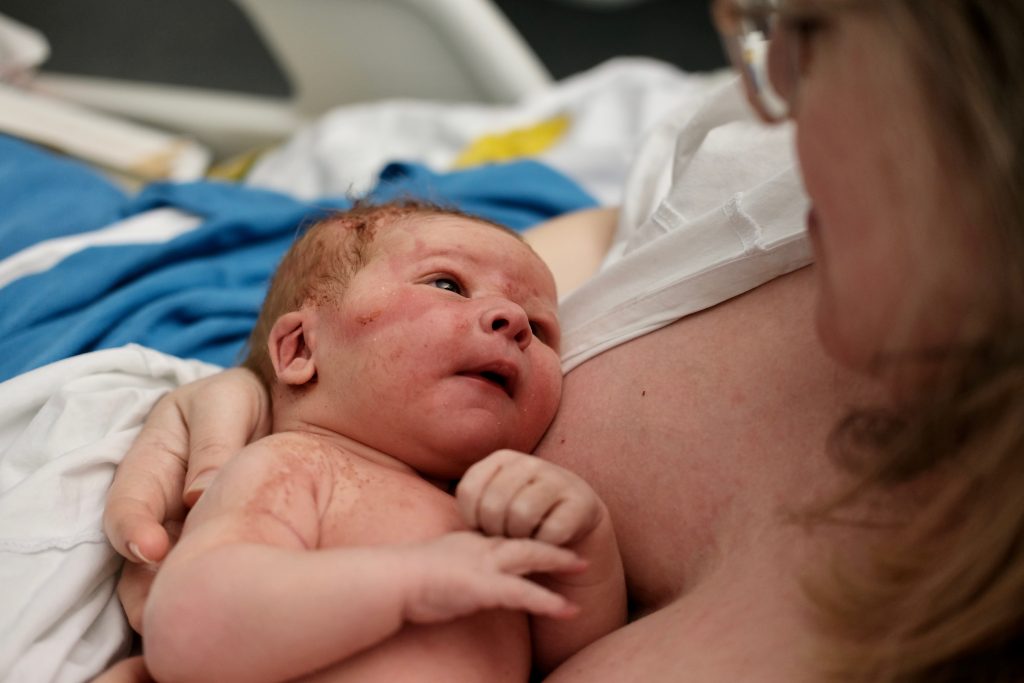
I celebrated in London with Mags at the Proms, listening to Beethoven’s Fifth played from memory by the Aurora Orchestra.
Ever since that moment, I started planning my visit to Sydney, Australia to meet my new grandson. Happily, I was able to go at Christmas, and could get away for a month. I found a low cost Business Class ticket leaving from Dublin to Melbourne on 20 December which would allow me to be there in time.
And so it began.
Tuesday 20 December – party in Brentwood, party in Dublin and fly business class to Abu Dhabi
After my birthday party on Sunday 18 in Brentwood with friends & family, and another in Dublin on Monday 19 with real friends & colleagues, I am ready and well prepared to leave on the 08:45 to Abu Dhabi on Tuesday 20.
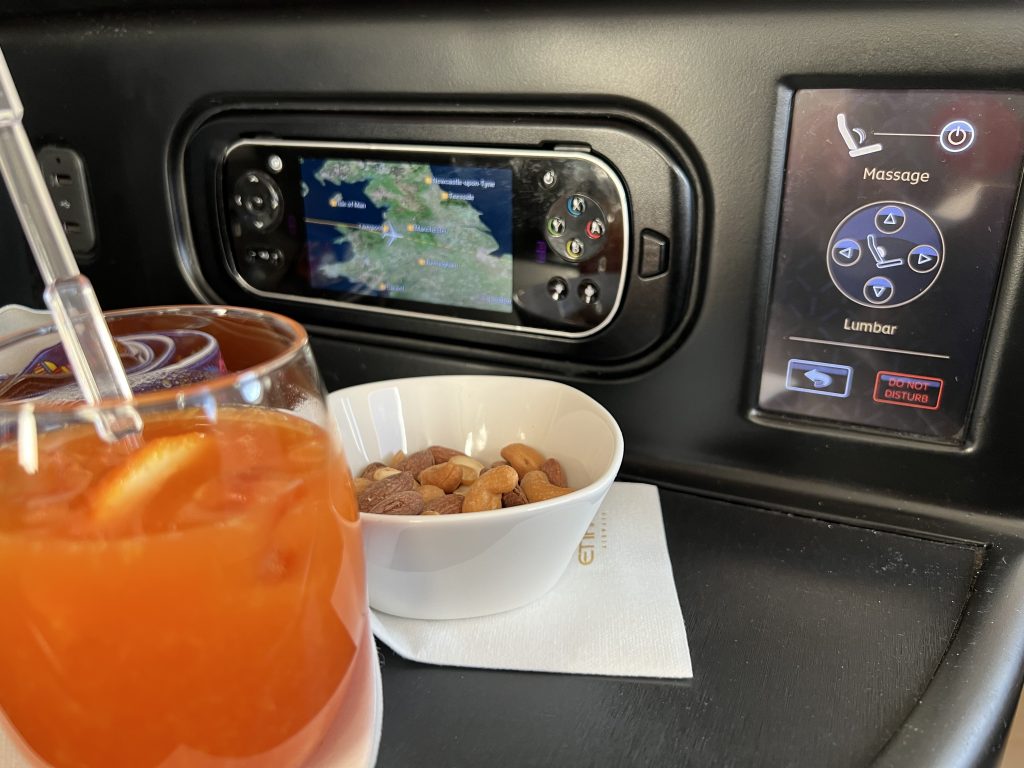
Lie down seats, a free night’s stay in Abu Dhabi, and the use of the Etihad business lounge allowed me to do most of the jet-lag adjustment in the journey. I was surprised how business class made all the queuing non-existent and the transitions short, and this made the whole experience relaxed & effective. Not to mention many nice meals, kicking off with a Campari, roasted nuts and a massage!
Wednesday 21 December – over the Indian Ocean
I slept most of the second leg from Abu Dhabi to Melbourne, as this closely matched Eastern Australian night time.
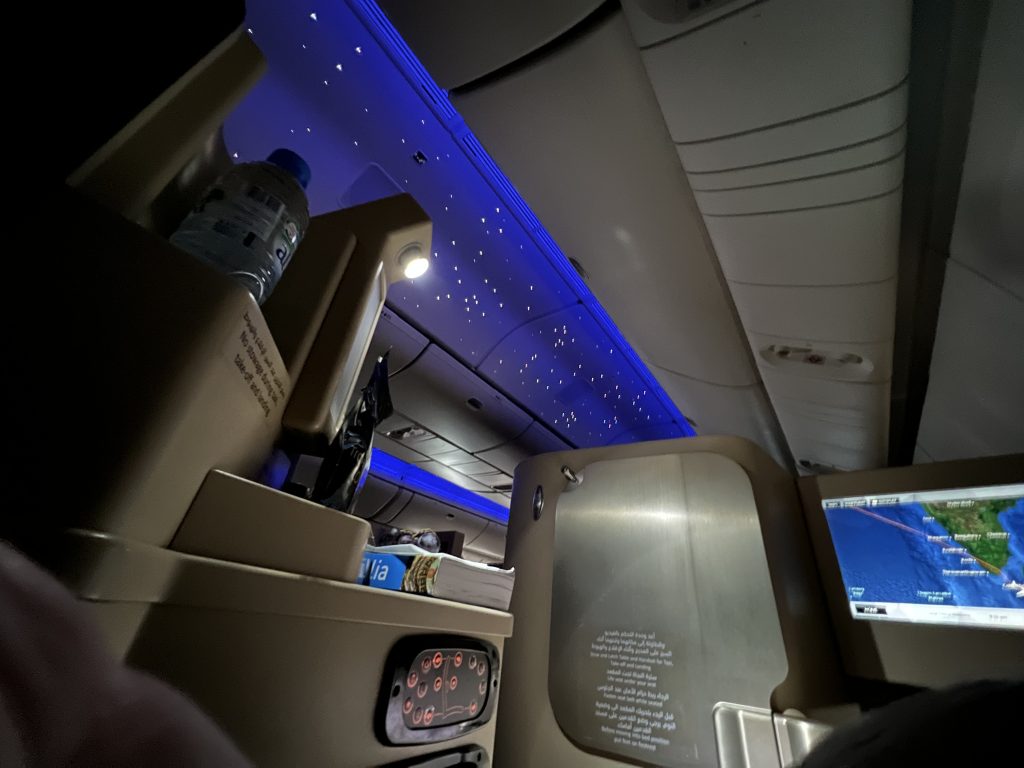
The lighting, of white stars on a blue background was delightful, but distracting, as no recognisable constellation could be identified!
Thursday 22 December – arrive in Melbourne, then Sydney to meet him
I landed in Melbourne at 6am, got off the plane quickly, collected my bags and was through immigration with hardly a pause. I persuaded Jetstar to let me on the 7:05am flight, so barely had time for a coffee before I was heading on to Sydney.
I was met by my son at the airport, who took me on the short drive to his home in an urban inner city district rather like Brixton or Camden Town is in London.
And there he was – the gorgeous boy!
Thus began two weeks of a wonderful, sunny respite, made up of Christmas and New Year with my family in Sydney.
Although for me it was the surreal height of summer, I felt happily indulged in the season’s pleasures of eating, drinking, walking, sleeping, reading books and excellent company.
But I also saw some sights.
Friday 23 December – Sydney and the Opera House
I took the train to central Sydney with my son, saw the Queen Victoria Building, bought some summer clothes in Myers, visited Dymocks book shop and then we walked on to the Opera House.
There were many childhood ambitions to fulfil in travelling to Australia for the first time, and a big one, seeing the Sydney Opera House, did not disappoint. The competition to design it was launched in the year of my birth and its completion in 1973 was also in my first year as an undergraduate at King’s College London. Modern architecture was a thing for me in school and remains so. Throughout my undergraduate years I marvelled at the new National Theatre being constructed across the River Thames from the university.
I found the Opera House exceeded my expectations as an architectural spectacle, with its vaulting interlocking beauty but also the geometrical detail and engineering. I filled my phone with images at all angles and marvelled at the ceramic ’skin’ and glass curtains.

Saturday 24 December – a walk in the park
In the morning I went for a walk to Sydney Park, south of Newtown. A pleasurable stroll through the suburban streets but a hot day, so keeping myself in the shade of trees wherever I could through Erskineville and returning up King Street through to Newtown.
When I stopped for a ‘Good Root’ drink at the Sydney Park Kiosk, I sent this message:

Little did I know that the name of the drink was Australian slang for sexual intercourse, as well as a lovely combination of beetroot, ginger, carrot and celery.
In the evening, my daughter-in-law’s parents came over after collecting her sister, from the airport and join us for a Christmas Eve meal.
Sunday 25 December – Christmas Day with the family
Christmas Day (and night) we gathered at the in-law’s house in Northbridge, enjoying lovely sea food and an amazing Pavlova.

We exchanged gifts – I got lovely Australian cooking ingredients, sweets, books and drinks from all the family slightly to my embarrassment (but immense pleasure) as I had thought that the Secret Santa was the thing – I’ll know better next time. My Secret Santa was chosen by my son’s mother-in-law – ‘Songlines: The Power and Promise’ by Margo Neale & Lynne Kelly. My son gave me ‘Dark Emu’ by Bruce Pascoe – more about both books later.
Monday 26 December – Boxing Day and a walk around Northbridge
A quiet day, as ever, eating delicious leftovers and taking it easy.
Before lunch, we went for a walk through the woods near Northbridge to nearby Tunk’s Park boat ramp, spotting bush Turkeys and Kookaburras on the way and Pelicans in the water.
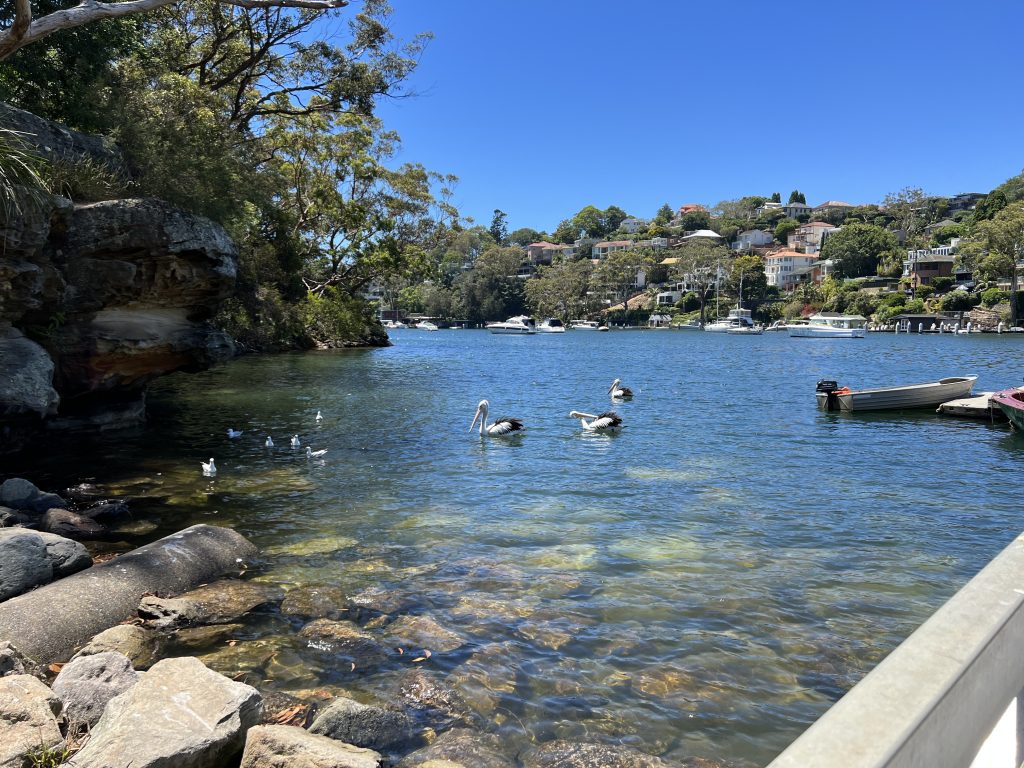
We made our way made our way back through Tunk’s Park and Flat Rock Creek, but without my daughter-in-law’s mother who sadly hurt her knee on the descent to the boat ramp and got a lift home from daughter-in-law acting as an ambulance driver!
Tuesday 27 December – walking, reading, debating and drinking in Newtown
Back at my on’s house, in the morning I went for a walk with him and grandson to a local park, but then started reading. My daughter-in-law’s mother , on giving me the Songlines book, encouraged me to start by reading a book that my son had on his shelf: ’Welcome to Country: A Travel Guide to Indigenous Australia’ by Marcia Langton.
I began reading it and realised that my new real interest (after being with family) in coming to Australia was discovering First Nations people, culture and history, not the rather comfy middle-class interest in colourful indigenous art I had planned, although that enthusiasm persisted and was well-served. Politics had replaced art in my mind, although as I discovered, there were close links.
‘Welcome to Country’ carefully and neutrally offered a fascinating description of Australia’s First Nations and then continued, state-by-state to propose the experiences to be found in each to engage with them.
I didn’t finish it at one sitting, but it was only the offer of drink which stopped me!
That evening my son invited me for a drink in the ‘Courty‘ – Courthouse Pub and we enjoyed a Newtown IPA and discussed the state of socialist jargon at length!

On the way back we stopped in King Street to have a drink in ‘Odd Culture’ – I had a glass of Cabernet Sauvignon – Brash Higgins CBSV Cabernet Sauvignon, McLaren Vale, South Australia – which was rich and delicious.
I had travelled to Australia to meet my grandson, but as much happiness was obtained in spending such relaxed time with my son and also getting to know my daughter-in-law and her family better.
Wednesday 28 December – Northbridge to relax and swim
I finished the ‘Welcome to Country’ book on a lazy day, when mostly, my grandson went swimming in the in-law’s pool!
Thursday 29 December – Royal Botanic Garden, First Nations guided tour and Yiribana gallery at the Art Gallery of New South Wales
I started reading the ‘Songlines’ book in the morning.
With the family, I visited the Royal Botanic Garden so that I could enjoy a guided First Nations tour which vividly described the encounter with the First Fleet, which consisted of eleven ships bringing the first settlers from Europe and Africa. There were two female guides, both of Aboriginal heritage. The first was strict with a would be photographer, assertive but humorous in tone!
Afterwards I rejoined the others to walk through the gardens, revisiting the scene of their Covid-delayed wedding in October 2021.
Finally we visited the Art Gallery of New South Wales.
I only managed to enjoy the Yiribana Gallery, one of the world’s largest collections of Aboriginal and Torres Strait Islander art, before we left for home, but that was because it was so enthralling and deserved all the time I had.
This one example introduced me to something that really excited me, but I discovered was not uncommon in First Nations art: a collaborative work that was painted for real purpose: to argue for land title.
The caption said:
“Men at Tjuntjuntjara, Western Australia, began creating collaborative paintings in 1997 as part of a native title documentation process, with the works being formally included in the preamble to the successful Spinifex native title claim of November 2000. “
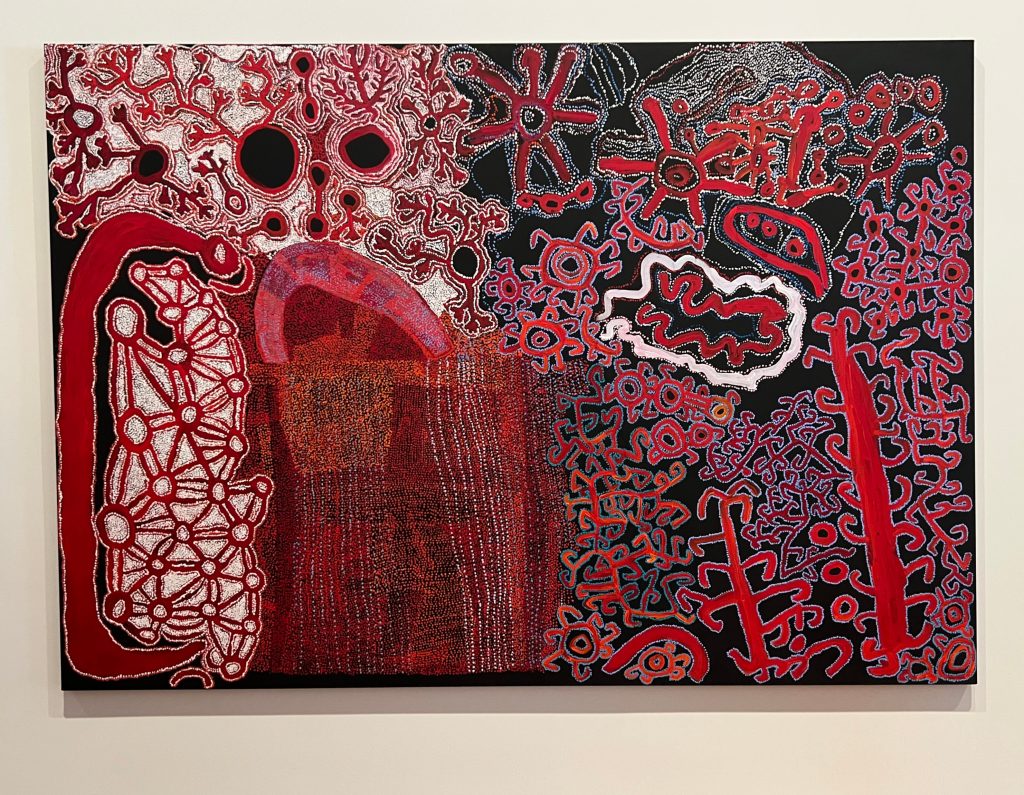
This work depicts the tjukurpa [dreaming] of the Wati Kutjara as it relates to Spinifex Country. Wati Kutjara are two men, the first beings, whose actions shaped and continue to inform connections to Country.
Artists: Fred Grant, b1943, Ned Grant, b1941, Simon Hogan, born c1930, Lawrence Pennington, b1934, Patju Presley, b1945, Wati Kutjara 2019 all of Pitjantjatjara, Southern Desert region, Australia.
Friday 30 December – Museum of Sydney and Thai dinner
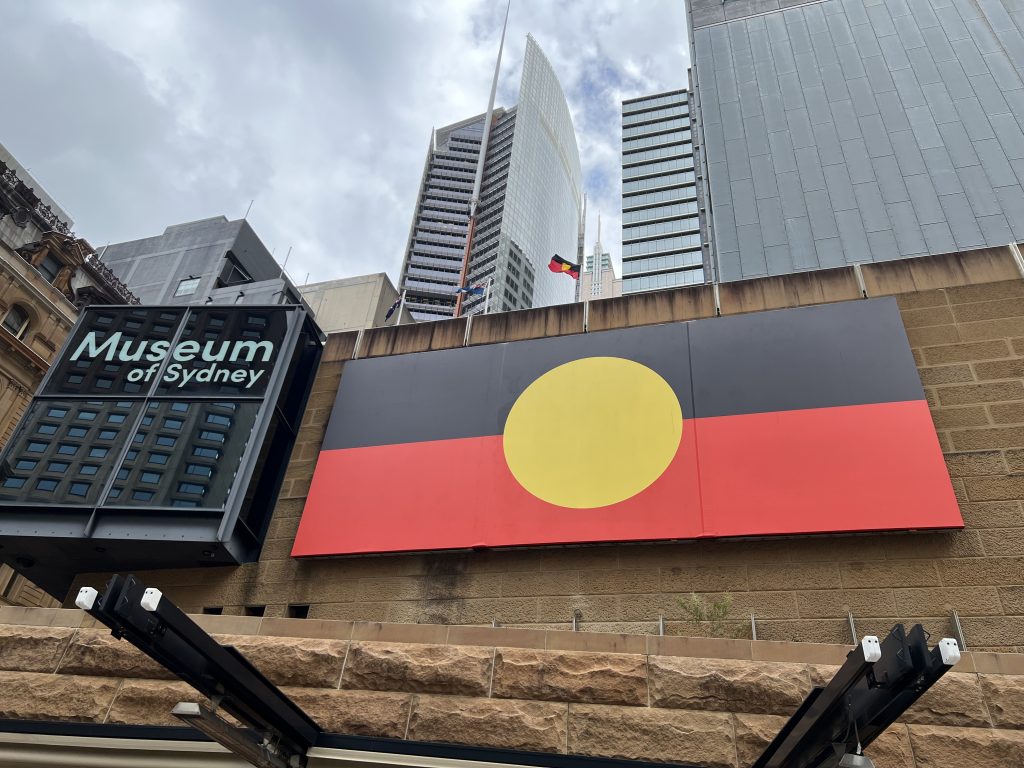
I went alone to visit the Museum of Sydney with its huge Australian Aboriginal flag, and had a wander through the centre. The Museum wasn’t huge, but had a very informative display with models of all eleven boats in the First Fleet, with explanations of which one carried what.
I also sat and watched a ‘First Australians’ film which explained the local Gadigal people’s encounter with the First Fleet and the story of Englishman, Governor Phillip, and the kidnapped warrior Bennelong.
I then found the General Post Office on Martin Place and wrote postcards to send to family and friends before setting off to join the others for a lovely meal at the Thai Pothong Restaurant in King Street, Newtown.
Saturday 31 December – New Year’s Eve in Northbridge
We met up again in Northbridge at the in-law’s house to celebrate New Year’s Eve and stayed the night. I enjoyed watching the fireworks on TV!
A day for continuing to read the Songlines book.
Sunday 1 January – New Year’s Day and a walk around Northbridge
More reading, and a walk with daugher-in-law’s dad (grandad – I’m grandpa!) to see the surroundings of Northbridge, some bush and sea inlets, some urban streets and a chance to compare house architectures. Excellent company.
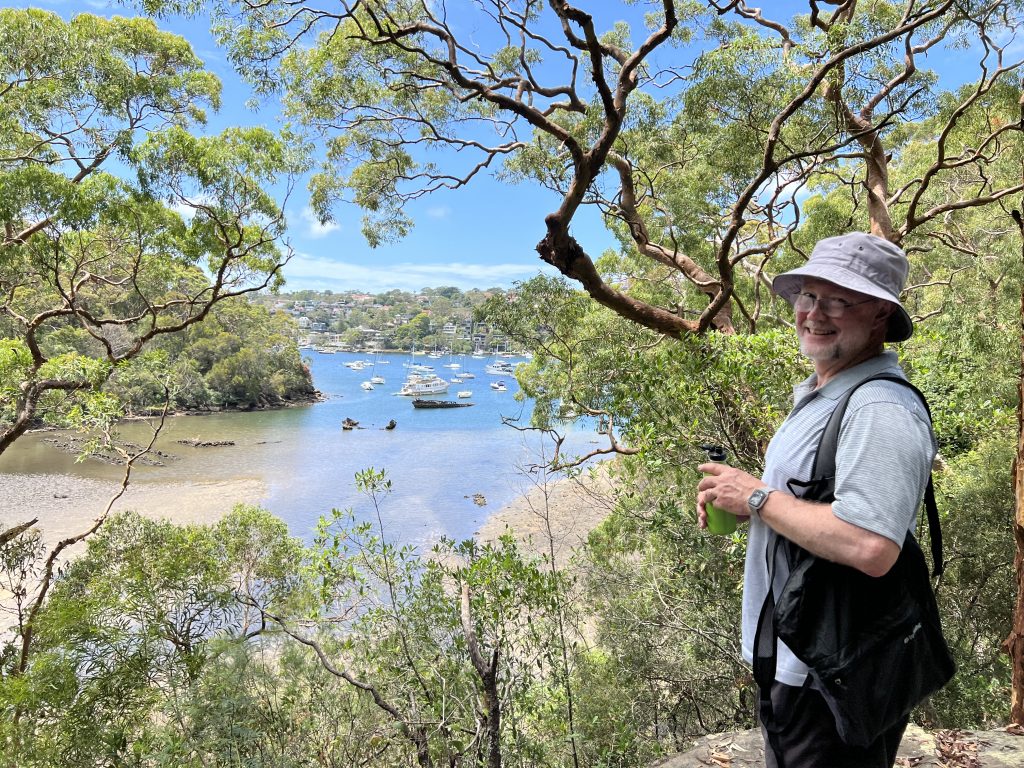
Monday 2 January – Fish & Chips in Kirribili
Another day for reading, but an appointment with all the family for fish & chips under the harbour bridge on the north side allows me to take a train and then the ferry to Kirribili.
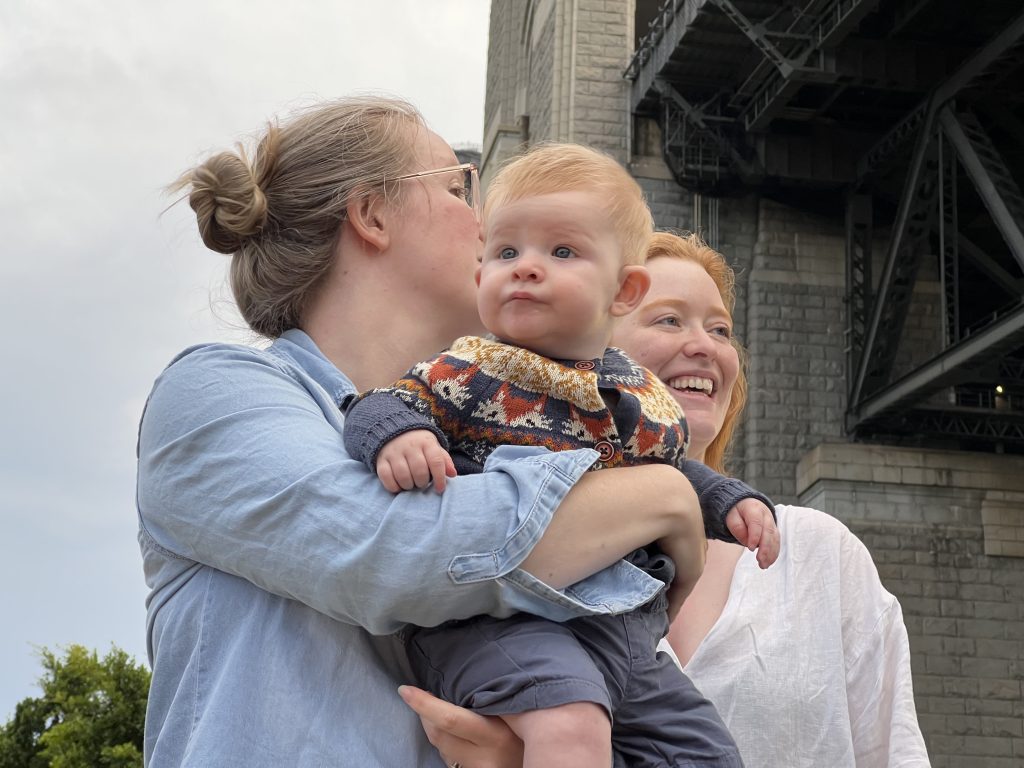
As we sit eating, my son sets up his camera to capture a time-lapse of the departure of the cruise liner ‘Celebrity Eclipse’.
Tuesday 3 January – Reading and DIY
A quiet day for more reading.
My son invites my help to erect a triangular sail to give shade in his backyard, so we make a trip to Bunnings, the Australian B&Q.
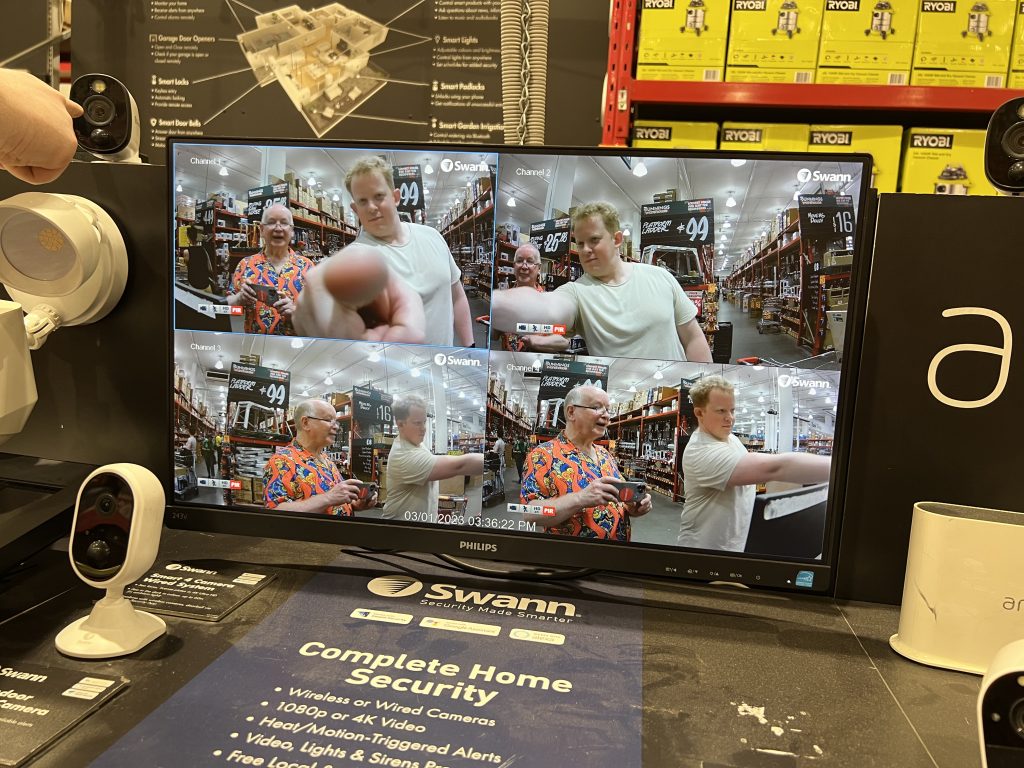
Wednesday 4 January – the Blue Mountains on a road trip to Canberra
My son kindly takes me on a trip to Canberra, and we start early to catch the morning light in the Blue Mountains.
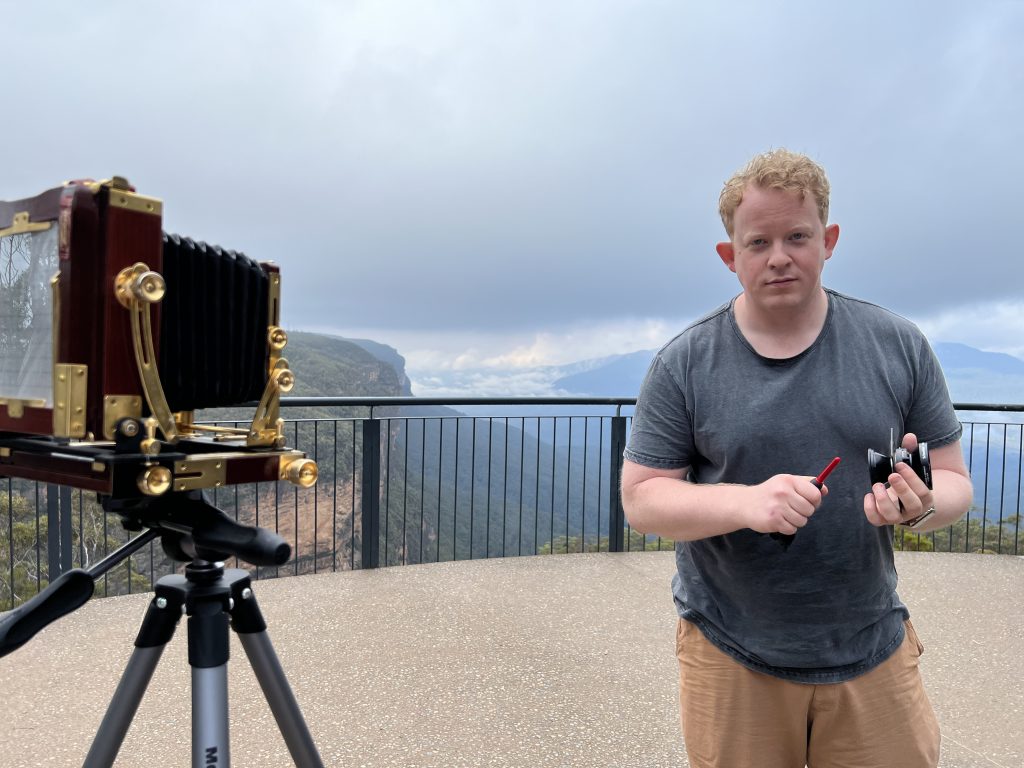
Our first stop was at the Wentworth Falls lookout to take photos using my son’s Tachihara Field Stand 4×5 (or 5×4 in English tradition!), before breakfast at the Mountain-Ama Cafe and hat buying in The Hattery in Katoomba. We then visited the Echo Point lookout to see the Three Sisters rocks and the Anvil Rock lookout overlooking the Grose Wilderness before setting off to Canberra.
It’s a long drive, and I am surprised by the lack of garages or shops on the road, which is mostly through farming country – where does anyone get petrol?!
We see a Wedge Tailed Eagle across a field and later a Kangaroo beside Lake George.
Into Canberra, we had a Japanese meal and were a little surprised by the parade of hot-rods that had gathered in town.
Thursday 5 January – Canberra
A tasty breakfast at the Local Press Café, Kingston before then visiting the the Museum of Australian Democracy at Old Parliament House. We walked through the Prime Minister’s suite of offices and watched a video of recent prime ministers talking about each other. We sat in the House of Representatives chamber before looking through the Democracy DNA exhibition.
I loved the way that small, but persistent protest was shown to be important for change to happen.
I was impressed with the paintings forming the ‘Statement: Jack Green’s Paintings‘, a series which made clear the impact of the mining industry on his Country, culture and community, which was recognised by a committee of inquiry into land title.
I was also moved by the exhibition on Equal Rights, and particularly the speech in parliament by Tim Wilson in December 2017 in the run up to legalising same sex marriage. At the end he proposed to his boyfriend, listening in the gallery.
We then had a look in the National Portrait Gallery before the National Gallery of Australia, which was generally excellent, but particularly remarkable for the Aboriginal Memorial, 200 decorated hollow log coffins from Central Arnhem Land – stunning.
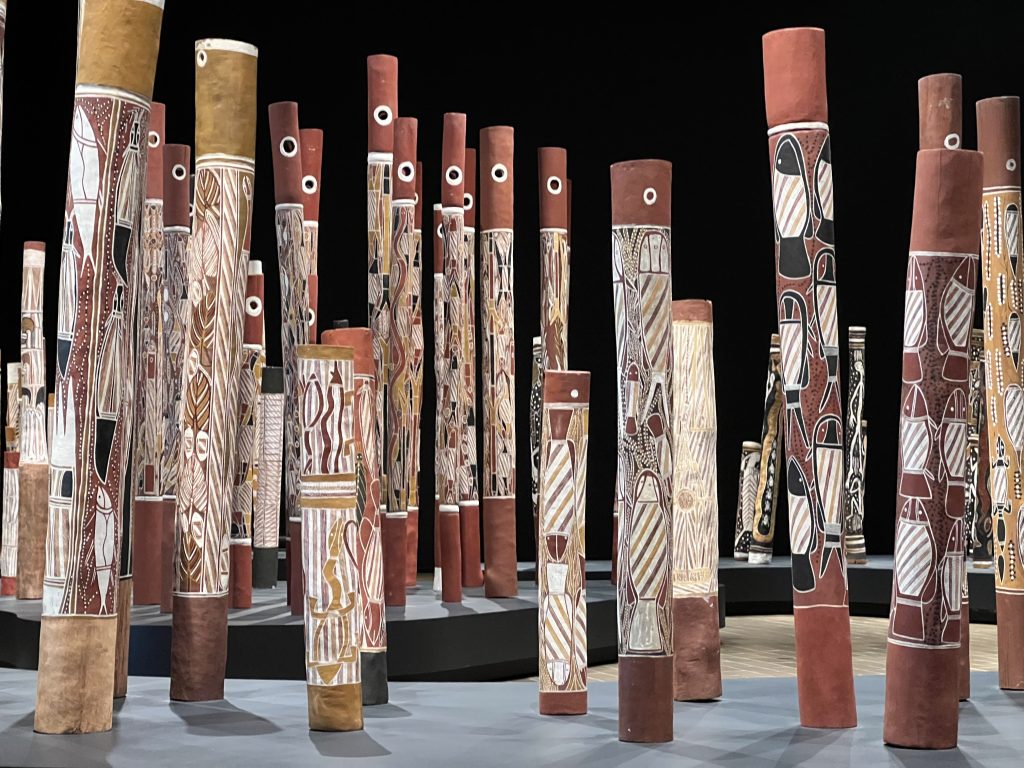
We then went for lunch at the National Museum. I noticed a tour, so went to buy a ticket, and found I was the only person on it.
Jake was my guide, a friendly student at the Australian National University studying international relations. He enthusiastically lead me round the exhibits, particularly in their depiction of the First Nations people and their terrible treatment by colonialists. Notably he showed me the braille messages secretly applied to the outside of the building by the architect, and showed me where they read “sorry” and “forgive us our genocide”.
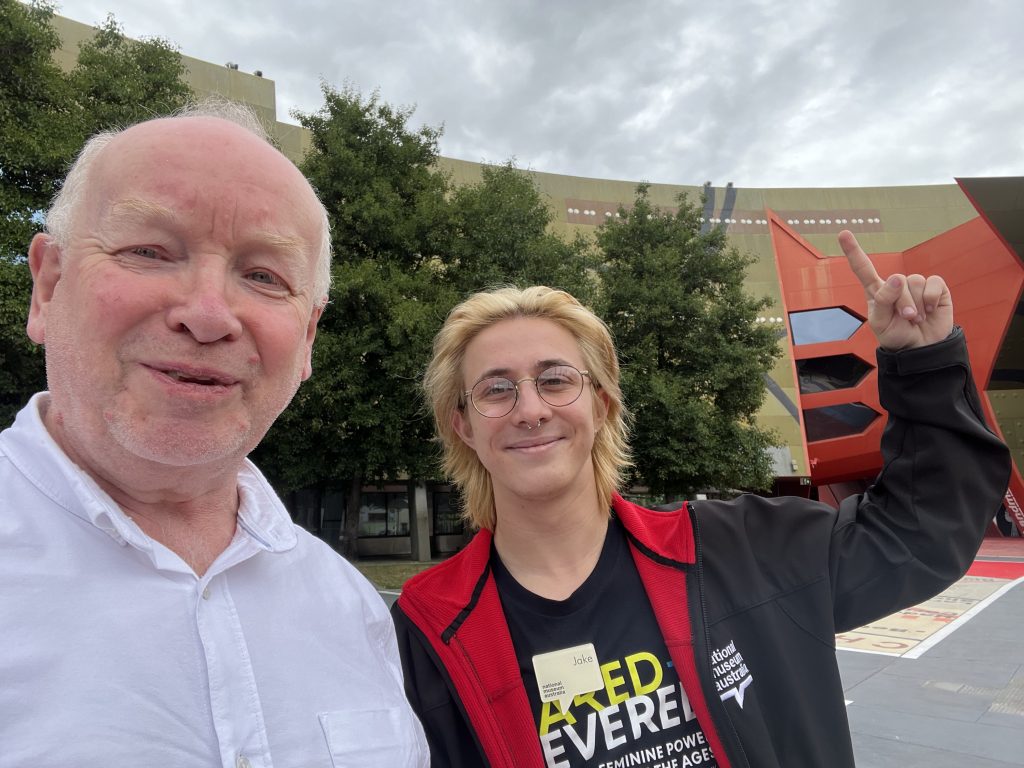
This apparently enraged Prime Minister Howard at the time of opening. Howard had refused to apologise to Aboriginal people for the ’Stolen Generations’, an act of extraordinary cruelty which separated children from their families.
Jake also told me about the building design of the First Nations section of the museum, which was claimed by the architect, Raggatt, to be a ‘quotation’ of the design of the Jewish Museum in Berlin by Daniel Liebeskind, causing some controversy through its implication of a link to the Jewish holocaust.
Before leaving Canberra, my son drove us up to Mount Ainslie lookout to have the view over the city.
Friday 6 January – reading
I finished Songlines – a fabulous book, and although I found some of its propositions difficult, the overall effect is that it explains a ‘Theatre of Memory’ model of knowledge in Aboriginal minds, that links country & fable with practical matters of food & water sources. (In 1990, when just started with Ultralab, I had helped produce a multimedia CD-ROM on this topic by Graham Howard’s Art of Memory company as part of the Apple funded Renaissance Project.)
It was a rich and enjoyable read, even if it occasionally overstepped a credibility mark.
So I started to read ‘Dark Emu’ by Bruce Pascoe that my son had given me. This book quotes from the unexpurgated accounts of Aboriginal life, that early colonisers’ wrote at the time, in order to to counter the primitive ‘hunter gatherer’ classification of Aboriginal people. The idea that Australia was ‘Terra nullius’, and thus no robbery took place, relies on a view that Aboriginal people were not sedentary, thus never in one place so they could make a claim to owning the land.
The accounts quoted contradicted this view, providing evidence of houses, cultivation, seed banks, fishing management and many other indicators of a more settled and ‘civilised’ people. Pascoe claims that land management by aboriginal people had been largely passive conservation, which might mean moving from location to location in order to preserve productivity, in contrast to the exploitative and damaging imposition of European high-productivity farming whilst ‘static’ on land you owned.
Most of all it challenged the mindset forming the European view of what civilisation is and of land ownership, with its diminished sense of common land (since the enclosures?). Country owns us, rather than we own country.
Saturday 7 January – completing the toy
I decided to try and complete the toy I was making for my grandson for Christmas (which year?), which I had started making in September! The toy was to be a spider, with hollow legs that when squeezed or chewed would react with sounds or lights.
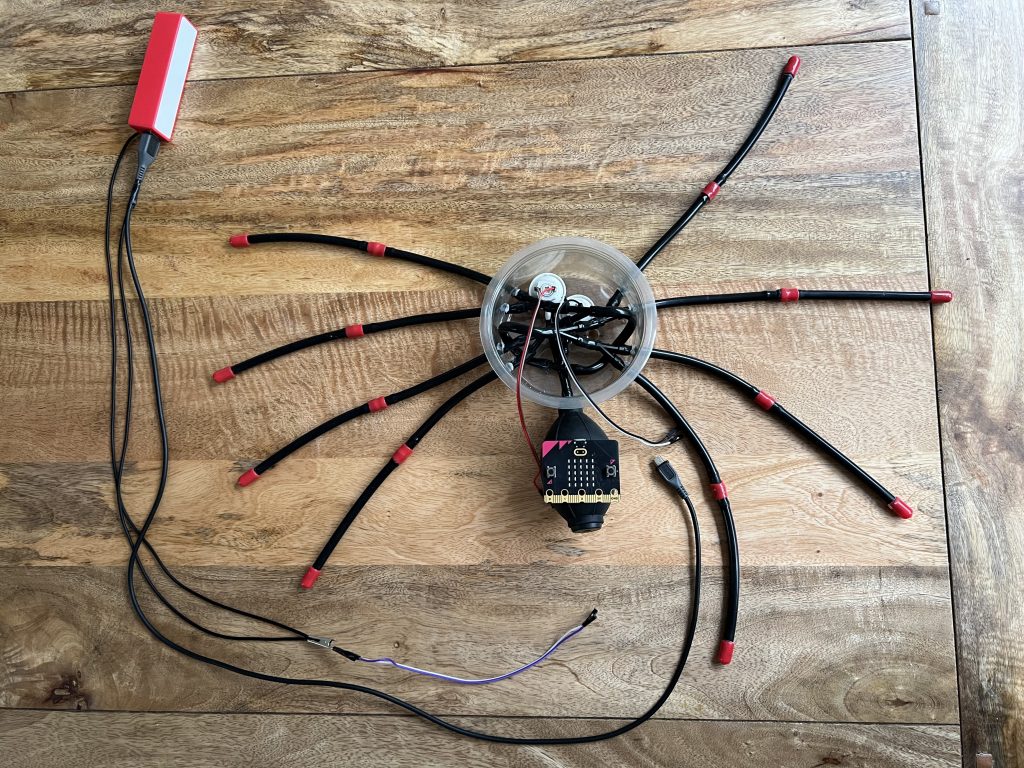
In addition, it would hang on a thread of a rubber band which has the property of varying resistance as it is stretched, so could be programmed to make sounds varying in pitch. The legs needed to poke through a black furry fabric skin, so I needed eyelets, which I had found at the shop All Buttons Great and Small in King Street, Newtown .
Sunday 8 January – Parramatta to Manly by ferry
I started early, aiming for a final lunch date with all the family at Manly beach.
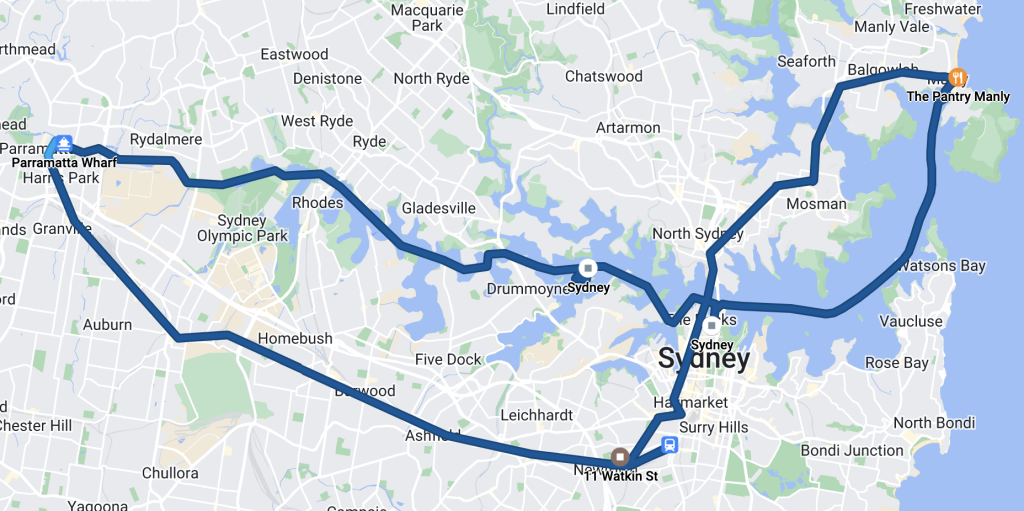
My journey began with a train to Parramatta in the western suburbs of Sydney (the opposite direction to Manly), where a wharf on the Parramatta River was the start of a watery adventure. I caught the first ferry of the day, which after leaving the river, speeded up as it zig-zagged to ferry landings on the north and south sides of Sydney Harbour. I stopped for breakfast on Cockatoo Island – a former penal island, quarry and shipbuilding dock, but now mostly a tourist attraction and camping ground.
The next ferry took me on to Circular Quay to catch my final ferry to Manly, located at the outermost edge of Port Jackson, AKA Sydney Harbour.
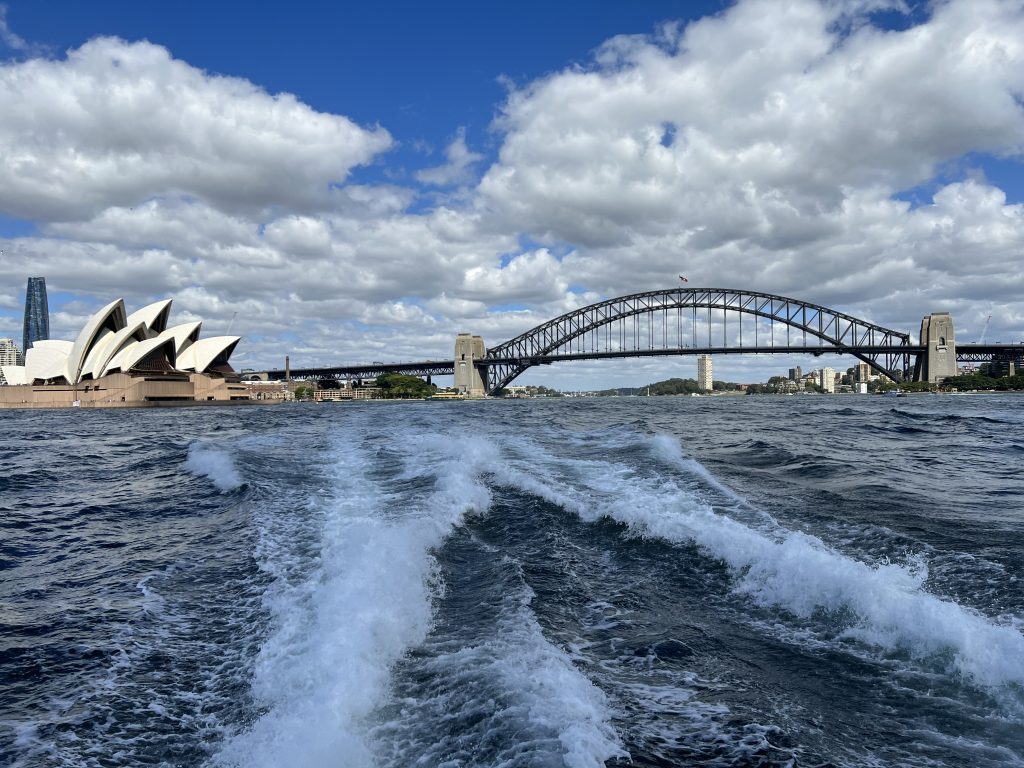
Manly is a resort, a little like Bondi Beach .
When I arrived there, it really felt like I was on my holidays.
The night before, my son had shown me an episode of Bondi Rescue which warned that the beach was somewhere to be thoughtful about risks – from rip tides to sharks. So I sat down to watch the world go by and see the surfers, newly aware of the dangers, but still surprised to see a group of lifeguards carrying a prone body up from the waves. It turned out to be an exercise, nevertheless, the risks are real – “During the first official bathing season in 1903, 17 people drowned on Manly Beach.”
To add to my ‘education’, after about half an hour, a woman accosted me, clipboard in hand, to ask me about government measures to allay fears about sharks! I learnt a lot from that interview about the different ways they were doing that.
I suggested they put warnings into the Sydney Transport app, which already warns me about delays due to sports events based on my journey planning etc., but could help me be informed about the shark risk if headed to the beach! My argument was that it would be ‘just in time, and place’ information.
I had a lovely ‘goodbye’ meal together in the Pantry with all the family, before setting off home for a quiet evening and more work on the spider.
Monday 9 January – the spider
I wanted to be sure the interactivity would work reliably, and decided to solder the wires to the Micro:bit controller. My soldering iron wouldn’t work, so had to use the bit heated on the gas cooker to do the job. I soldered to the back of the edge connectors to look neat, and nothing worked. Who knew that the back plates on the edge connector were unconnected internally!?
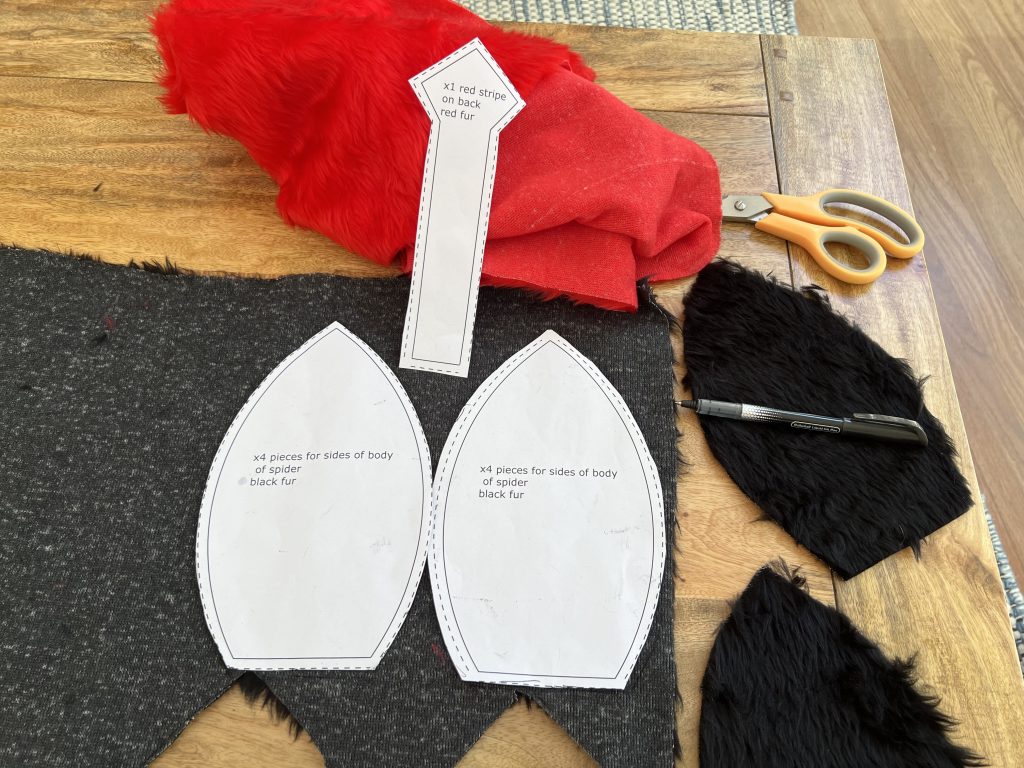
My daughter-in-law did me the kindness of using her overlocker to sew together the parts of the body and the head, and I hand sewed a clear plastic protective plate to the head to cover the Micro:bit, with a hole for the two buttons A & B. I had modelled it on a red-backed spider.
Symbolically, the Micro:bit’s LED lights would become the spiders’ eyes, normally 2 to 8 in number in real spiders, but in this case 25! I had used another plastic tub as a receptacle for the legs and wires to be protected. I made the holes necessary for the legs and wires to pass through and finalised the design to incorporate the USB cable. This would allow the Micro:bit to be powered from a cheap rechargeable battery pack and re-programmed, despite the Micro:bot itself being buried inside the head.
Work continues, but I had to acknowledge I wouldn’t be finishing my grandson’s toy on this trip!
Tuesday 10 January – Art Gallery of New South Wales and Amadeus at the Sydney Opera House
My last day in Sydney! So going out with a bang, I spent the afternoon revisiting the Art Gallery of New South Wales and viewing all that I missed on the first visit. It is an exceptional place, with rich & stimulating collections that I thoroughly enjoyed seeing. I was impressed with the technology used to fill walls with dynamic and exciting art, some very modern – an aesthetic treat for the eye.
Afterwards, I met my son for dinner at Matteo Downtown in Bond Street – a delightful meal as a prelude to watching ‘Amadeus’ at the Sydney Opera House, in itself a double whammy as the play was good, but the interior of the building also delighted.
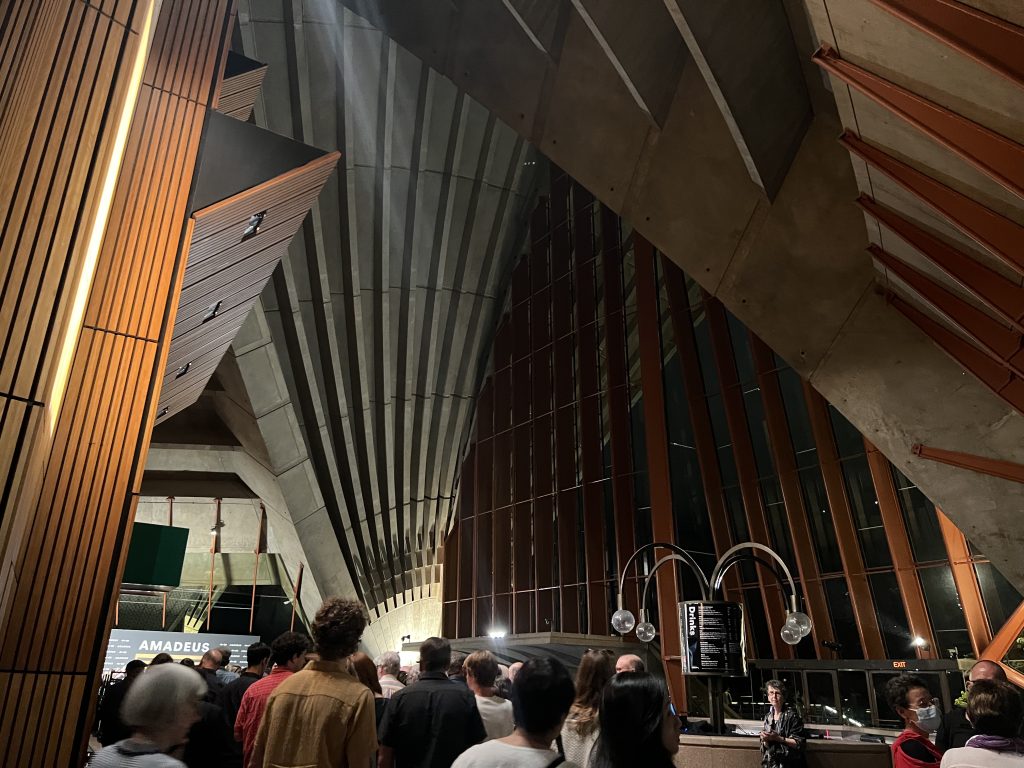
All in all, I was completely fulfilled as a parent, to have the shared time, the conversations, the collaborations and the care with my son.
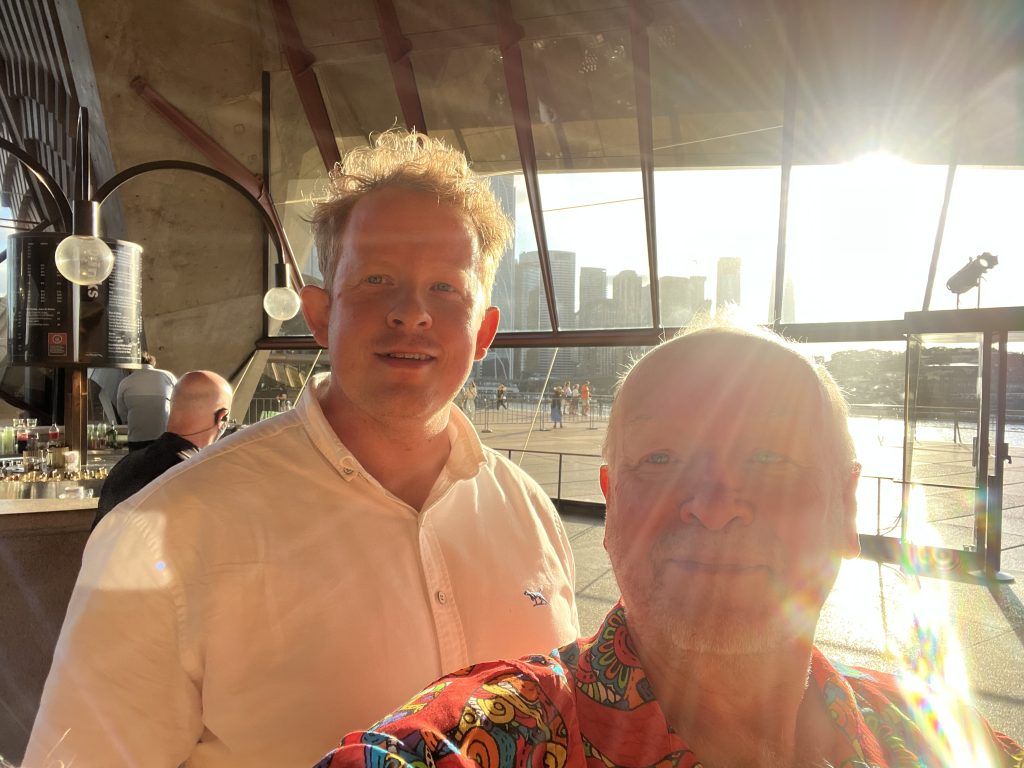
Wednesday 11 January – train to Newcastle
I said my goodbyes and set off, armed with Tim-Tams supplied by my daughter-in-law ( she is very thoughtful, and organised!), on the train to Newcastle to meet old acquaintance Peter Twining, Professor of Education (Innovation in Schooling & Educational Technology) at the University of Newcastle.
Peter moved to Australia in 2019 after working at the Open University and in Teacher Education. We had first met in 1990 at an ITTE (Information Technology in Teacher Education) conference in Bangor, North Wales and kept in and out of touch over subsequent years.
Peter met me at Cardiff station on the outskirts of Newcastle, after a very pleasant train journey through wooded valleys and inlets from the sea, especially the part between Hornsby and Gosford.
Peter’s home was on Stockton Beach with an outstanding view over the beach and the Pacific Ocean in a seemingly peaceful and secluded setting on the north side of the Hunter River – a ferry could take you into the town centre on the south side, but otherwise it was a longish drive around to get there.

Having been out of touch and feeling the peace & seclusion in Peter’s beach-front house obscured three unexpected (to me) matters:
- Peter’s wife Hilary had passed away earlier in 2022 and Peter was in the midst of preparing to drive round Australia in a camper van with lovely new partner Cathy – he was going through a real life-changing hiatus.
- Stockton Beach was eroding, threatening the road and houses, including Peter’s house, which he has luckily sold.
- The erosion was caused by the change in tidal / wave behaviour brought about by the breakwaters for the entrance to the largest coal exporting harbour in the world.
A long catch up with Peter that evening helped me to understand all about the first matter, as we shared our recent histories, but awareness of the other two grew on me over the next days.
Thursday 12 January – book editing, van testing and beer tasting
The day started with me waking before dawn, and deciding to get out on the beach to see the sun rise over the Pacific – needless to say it was beautiful.
Peter had invited me to help with house clearing, which he was in the middle of, but more interestingly he also asked if I would help him by reading the book he was writing with Dr Fiona Aubrey-Smith on changing your pedagogical beliefs in the context of technology in education.
I spent most of the morning happily sitting in the living room overlooking the ocean and reading through the draft and adding my reactions. It was very much my interest, and a pleasure to then debate some of the issues with Peter.
Later we went to look at the camper van they were buying to check that it was in good order (there was a saga about that).
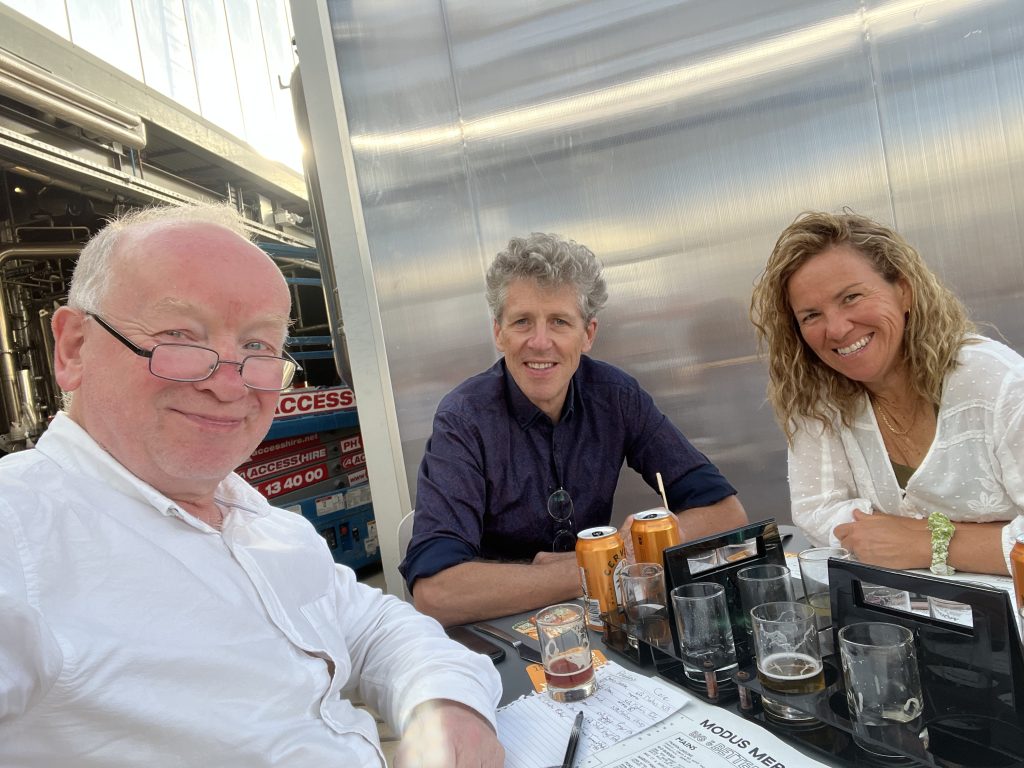
We had dinner at Meriwether Modus in Newcastle – a brewery / bar / restaurant.
I had a lovely vegan tempura burger with chips and shared spicy mushroom wings. We tried two tasting paddles’ of all their beers, but the ‘fruity’ ones were much too sour for my taste. Despite being a bit of traditionalist, I still like an innovative IPA and in general I found the Australian IPAs as good as in any microbrewery in the UK. They had no vegan ice cream so we set off for Derby Street but were frustrated and ended up visiting the supermarket to cater for our pudding lust – something Peter has been noted for!
I really enjoyed eating vegan all the time I stayed with Peter and grateful for the opportunity to give it a go.
Friday 13 January – surf boats, coal, and a flight to Melbourne and Little River
Another early walk and paddle, and even before the sun was up, I saw a small group of early-rising ‘boaties’ rowing out in a surf boat, I assume for exercise and to practice their skills.
There is a long history of life-saving activities from the 1860s when the ‘Stockton Rocket Brigade’ were formed. The sea around the harbour entrance is treacherous with sandbanks and many shipwrecks needed people to be rescued in the early years. As I saw later, the coal ships coming in were guided by three tugs to prevent further shipwrecks.
I was beginning to really get Newcastle’s status as a coal exporting port, as I watched the queue of ships from Peter’s balcony lookout, coming to collect the coal piled up in Newcastle by trains from the mines of the Hunter Valley inland, destined for places like Japan. They moved silently, belying their deadly cargo in relation to global warming.
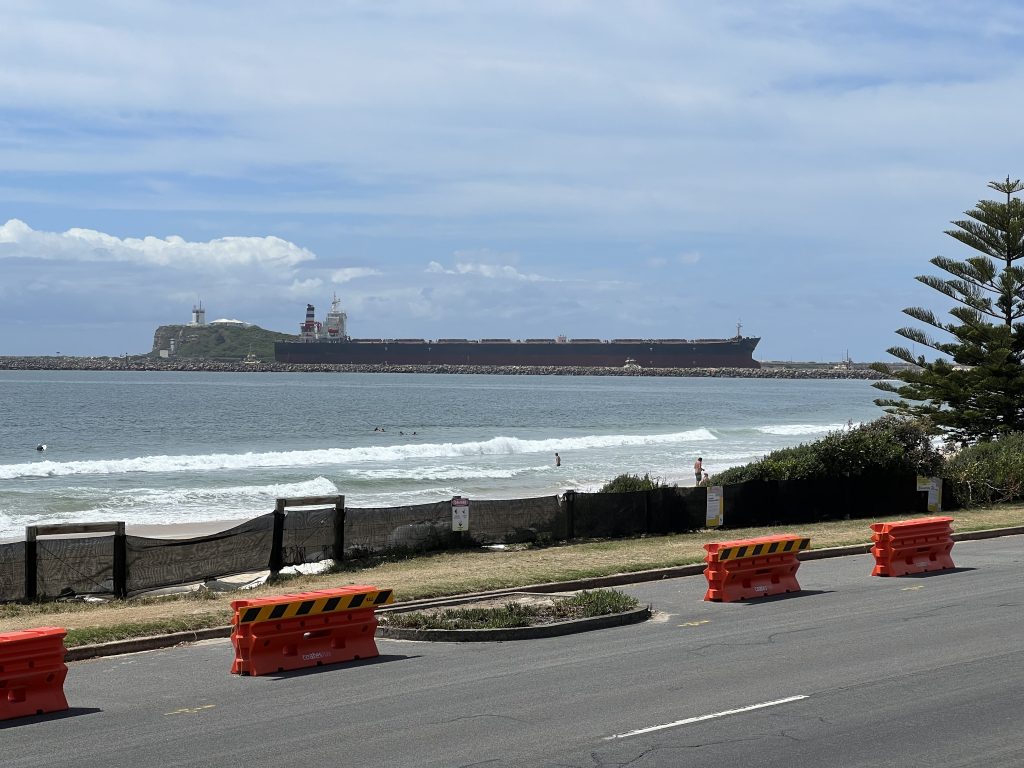
Only last summer (August 2022) I was on holiday and stumbled on Hambach in the countryside west of Köln, which turned out to be Germany’s largest open-cast brown coal mine. Greta Thunburg has only recently been visiting another nearby mine, where a protest to stop its expansion is underway. Ironic that I should stumble on both Hambach and Newcastle, since my voyage to Germany in particular was partly to prove my electric car could do such a road-trip without too much trouble. It seems I’m fated to visit some of the most dangerous places for our planet’s future.
Later, Peter took me to the airport to catch a flight to Melbourne, hire a hybrid car and drive to meet Gina in her lovely house in Little River, which I found in the dark. Although Gina was an early sleeper, she got up, as we had to spend some time picking up on the fifteen years or so since we last met!
Saturday 14 January – the Koorie Heritage Centre and Victoria Gallery in Melbourne
Gina was busy organising a birthday treat for her friend Leanne, but her group of friends generously welcomed me to their birthday breakfast. I learnt that Leanne had just registered for PhD and wanted to look at Computational Thinking in primary education.
Like many such students, there is no support group outside of her supervisory arrangements. I hope she will join the group I and Mags have formed, and which has been so useful to its members (and me).
I took the train into Melbourne to visit the Koorie Heritage Trust and the National Gallery of Victoria. There was a tour in progress within the Koorie, but the young guide had no problem letting me listen in, as he talked about his Aboriginal heritage and explained some of the artefacts in their collection. Their shop was filled with gifts made by First Nations people, with the promise of the profits being returned to them, so I got a couple of presents there. I later visited the National Gallery of Victoria down the road and had a look round their modern art collections.
I had missed that their Indigenous art collection was in the Ian Potter Centre, a building next door to the Koorie Heritage centre, but luckily I had time to walk back there before closing – well worth it, it was tremendous.
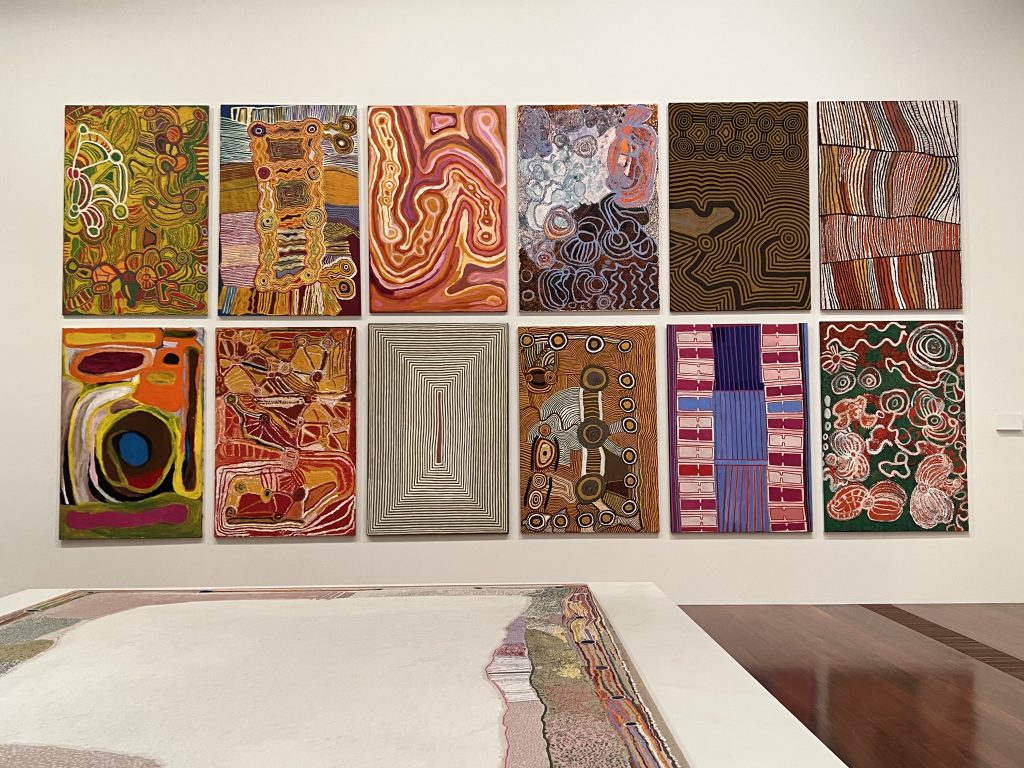
Sunday 15 January – Bunjil in the You Yangs
Gina and I rose early to drive into Melbourne and pick up our friend and ex-Ultralab-colleague Ali Gee who was house / dog sitting there.
Since we last saw each other back in around 2008, Ali had been an active Voluntary Service Overseas volunteer, busy in The Gambia and in Papua New Guinea applying her expertise in education & technology. It was a real pleasure to be reunited, and we spent the day walking and talking in the You Yangs Regional Park.
First we took Gina’s dog Leo for a walk, encountering a mob of Kangaroos at the entrance to the park. Gina led us to a geoglyph (an arrangement of rocks) about the size of a football field, which Gina challenged us to guess what. My best guess was it might be a figure of an animal (after wondering if it was for corralling animals).
Later, after another scrumptious breakfast, we went without Leo to climb Flinders Peak, the central mountain in the You Yangs. Only just a mountain, at 1034 feet, it was an easy ascent on well made paths.
Part way up, we stopped to view the geoglyph below, which turned out to be the outline of a giant Wedge-tailed Eagle, the form taken by the local Dreamtime creator deity named Bunjil. The massive granite boulders that surrounded the path, the smiling & friendly climbers we met and the views from the top were fantastic, but the best part was the company, and our conversations on the way up and down!
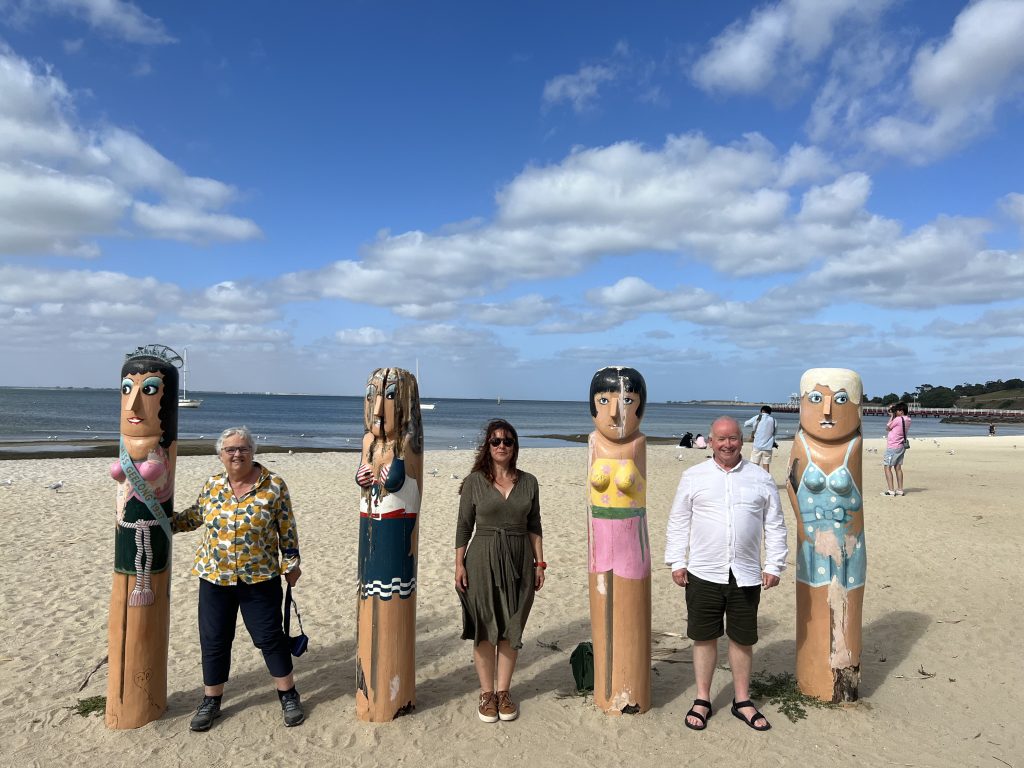
After the You Yangs, we drove to Geelong to enjoy an ice cream and a stroll around the foreshore viewing Jan Mitchell‘s broadwalk bollards, before returning to Little River to have an enjoyable meal in the local pub. It really felt like an authentic Australian family venue.
Monday 16 January – Brambuk in Gariwerd
I set off from Little River in the hired car heading for Gariwerd, AKA the Grampians National Park – there has been controversy about its naming. The mountains are quite unlike the Scottish Grampians!.
On leaving, I paused again in the You Yangs to take the short walk to the Big Rock which was a significant aboriginal site, and that’s how it felt. I was lucky to see a male ‘superb fairywren’, a well deserved name, chasing after several females between the massive granite rocks. The male superb fairywren is known to pluck yellow petals and display them to females in courtship display!
I continued towards Ballarat, at first on dirt roads, stopping briefly in Buninyong to shop for lunch. On the way, at Anakie, I saw signs for ‘Koala Country’, and the wooded road through Steiglitz looked good for Koala spotting but I didn’t get lucky.
Steiglitz is an old gold mining settlement in the Brisbane Ranges National Park (not anywhere near Brisbane), whose population at the height of its success was 2000, dropping to 8 at one point.
Finally I arrived at Halls Gap and the Eco YHA Hostel (YHA stands for Youth Hostel Association). What do you mean I am not a youth!?!?
I had booked a quiet double bed in a private room and enjoyed the lovely communal atmosphere in the shared kitchen and living areas. It was just the same as the YHA experience I had when travelling in Vienna with my youngest son Sasha on a music-culture break in 2009.
I stopped by the visitor centre, which had just closed for the day, but the guide on her way to her car told me I could walk around the centre and have a look at the wetlands behind, so I did and was immediately rewarded by grazing kangaroos and also a good look at the Brambuk cultural centre which had sadly closed the year before. It was owned and managed by Jardwadjali and Djab Wurrung people from five Aboriginal communities with historic links to the Gariwerd-Grampians ranges and the surrounding plains. I suspect it is a hiatus, as a refurbishment is promised and a re-opening later in 2023. I could see it was set up to offer Aboriginal experiences to tourists. The design of the roof of the building was modelled on a Cockatoo (a local totem, named Brambuk) with outstretched wings, also intended to echo the surrounding mountains. Cockatoos were in abundance, the equivalent of pigeons in Trafalgar Square.

I asked the youth hostel manager where could I see the sunset best, and he directed me to Reed’s lookout a short, winding drive out of Halls Gap.
Sensational. See the photo at the start of this blog.
At one point, after the sun had set (and most tourists had left!), Venus and Saturn, Jupiter and Mars were hanging over a pristine-looking Gariwerd, with its immense expanse of unspoilt bush and saw-tooth peaks piercing a velvety cyan sky.
Tuesday 17 January – rock painting in Gariwerd
I was slow to start this day, but got down to the visitor centre to ask for advice on visiting rock paintings, one of the strengths of the area is that some 90% of Victoria’s rock art is here. There are five curated spots in Gariwerd, but to visit them all in a day was just too much. I chose to drive to the more remote two in the south and west of the park and the visitor centre suggested a route, which they assured me was on good roads. In fact they were all dirt roads through the middle of nowhere, luckily not so rough as to demand a four-wheel drive, just slow work. I saw no-one else all day, neither on the road nor at the rock painting sites, although I was blessed with sightings of Emus and an Echidna on the way.
At the Manja shelter I had a twenty-minute walk along a well made path, brushing through ferns and wonderful wild flowers at times and across a boggy patch on a board walk, but not overly strenuous. The anticipation was raised by huge rocky outcrops, acting like sentinels on the way, and at the site a sprawling, huge and colourful beast of a rock below which was the shelter, fenced in to prevent defacement. The paintings were faint and took time to discern, but the knowledge of their age combined with the drama of the overhanging rock was compelling and moving. I walked back feeling I had been somewhere significant.
At the Billimina shelter all this was amplified. A shorter, steeper climb, although entirely manageable, went past a small waterfall and through flower-laden bush ending up at a gargantuan overhanging rock – even the widest lens on my phone could not capture how it felt to be standing under it. Here the paintings were more prominent and numerous, and there was a real sense of being in a place where people had been for tens of thousands of years – profoundly amazing.
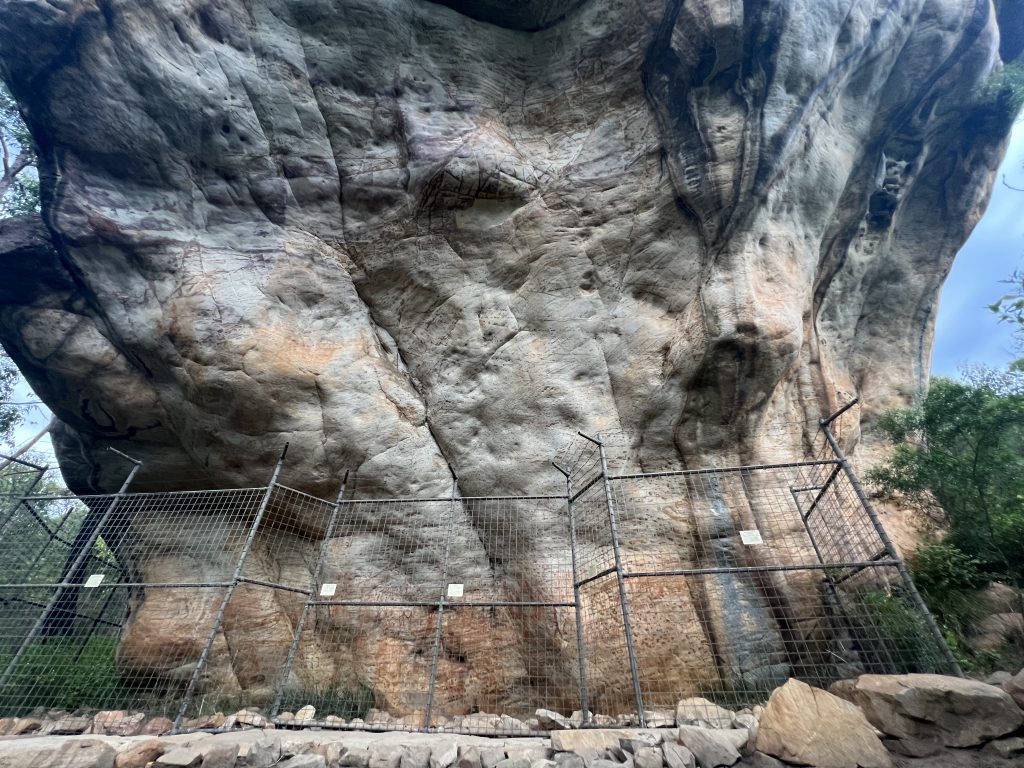
I returned to Halls Gap in the dusk & dark on the main roads going around the park. The sheer number of kangaroos springing up everywhere surprised me, and I found myself braking sharply to avoid one careless jaywalker (jayjumper?).
Wednesday 18 January – Tower Hill and the Great Ocean Drive
I left Gariwerd and headed south to the Tower Hill reserve, where I had booked a guided tour. Tower Hill is a former volcano – a circular caldera with a central island contained by a lake. With a chequered past of colonial abuse as a site, it is now restored to a beautiful natural reserve and its cultural centre tells us about First Nations people – their life and culture.
Until now I had been ticking off my mental bingo card of Australian things to see, and so far had not seen a Koala or a Black Swan (except at a long distance). So imagine my delight as I pulled up at the visitor centre and in the tree in front of me was a nonchalant Koala! Later I saw Black Swans on the lake.
We soon started the tour, about fifteen folk, adults & children, sat in the cultural centre and invited to sing songs and hear stories of Aboriginal life. Brett, our cool and funny guide showed us wooden tools and told us stories, some harrowing, about his family and his people’s experiences, but all with a gentle and forgiving voice.
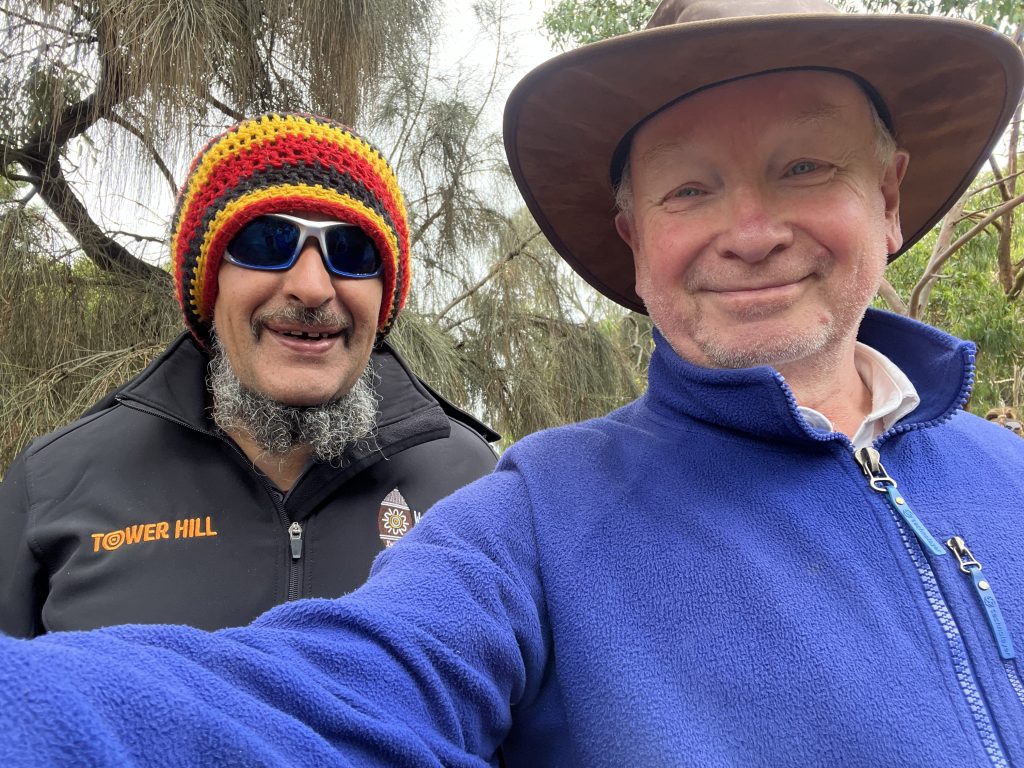
We then went for a walk round the park, encouraged by Brett to taste several tasty plants and we continued a friendly dialogue with Brett as we walked.
He also told us about his continuing practice as an artist and musician and told us about his exhibition in the gallery in Warrnambool, a nearby town. Warrnambool happened to be on my way for the next leg of my journey, back East along the Great Ocean Road to return to Gina’s house in Little River. I stopped by the gallery and really enjoyed seeing and hearing Brett’s work.
The Great Ocean Road seemed to me in three parts, at least starting from Warrnambool.
First, relatively flat and without great views except for the stops at lookouts for the Bay of Islands, the Twelve Apostles. I stopped for lunch at Port Campbell.
Second, I enjoyed the tall stands of trees in the forests of the Great Otway National Park and seeing the vistas occasionally opening up (for example at Johanna Beach) before stopping at the resort in Apollo Bay for an ice cream.
Third, the stretch along to Geelong which for the most part hugs the beach and then rises to round headlands and repeat. Delightful and a proper ocean drive!
I returned in time to chat again with Gina briefly, discovering more about her current work as a learning designer.
Thursday 19 January – going home
A pleasant conversation with Gina’s friend Margaret over breakfast, before setting off to catch the flight home.
I couldn’t help but wonder about the landscape visible from the plane as we flew over central Australia – it reminded me of many of the paintings I’d seen, in both colour and form.

Postscript
I returned to Dublin early on 20 January in time to do a little work with Louise, my colleague on the OurKidCode project before joining Nina and Glenn and Mags for our postponed Christmas lunch.
Mags and I then spent a little time preparing for her viva the following week (did I mention Dr Margaret Mary Amond got her PhD?) before setting off home for Brentwood arriving at 3am after a delayed flight and a hike through East London.
I didn’t surface for two days – exhausted but supremely happy.
I had been delighted on so many fronts – happy times with family, excellent catch-ups with friends and never-ending intellectual, political & aesthetic stimulation.
I can’t wait to go back.
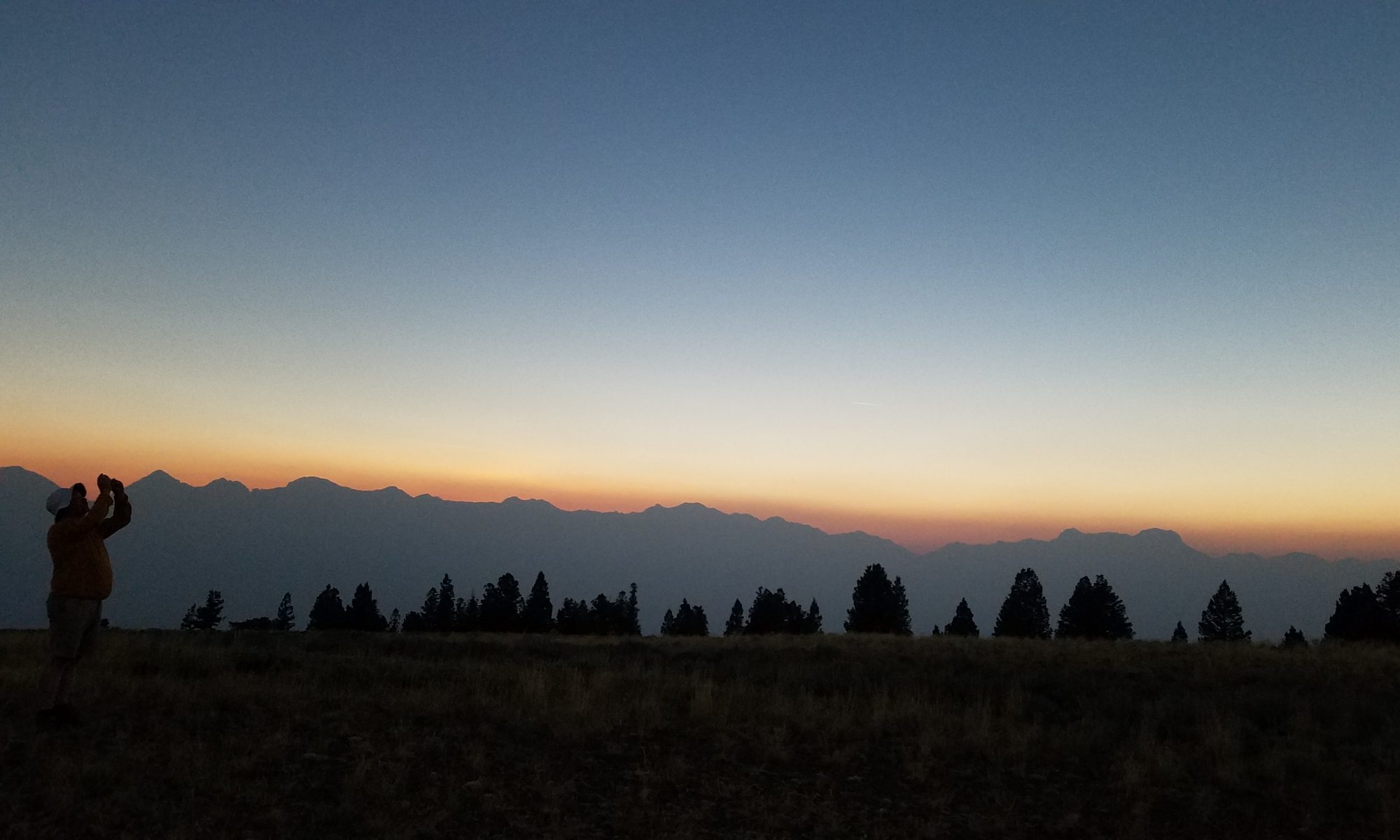
Hi Richard. Sounds like you had an amazing time, might refer to your blog, when planning a trip to Oz, as you’ve discovered do many nice places. Remember to include NZ in your next visit x
An absolute joy to read – my morning commute flew by! It’s heartwarming to read your own descriptions of places I remember (Canberra and Great Ocean Road in particular). Not as heartwarming, of course, as the time you spent with your family, old and new, which moved me greatly.
Good to have you back!
Well my friend, I have just completed reading the full blog. Amazing doesn’t cover it. You’ve definitely put the tech work in as the story deserves. The family and friends parts are brilliant. No wonder you want to go back as soon as possible.
It was very strange, though, every time I see or hear anything about first nation, Australians, I feel so sad and not a little personal shame. I for one, have no hesitation in saying I am sorry for what happened to 1st nation people in Australia, and in other countries where the Britain Elite abused indigenous peoples and their countries.
Having said that it is good to have you back Richard. You’re amazing Trip has reminded me of a similar trip my wife, Mez and I, took for our 25th wedding anniversary world tour, including spending a month driving round both islands in New Zealand. Wonderful memories! That was 25 years ago.
Looking forward to linking up with you when ever you’ve got time.
Keep well my friend.
Yours Aye
Ian